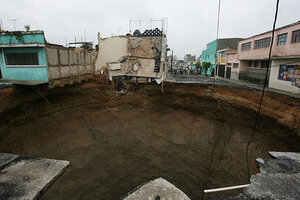Another giant Guatemala sinkhole? Geologists brace for it.
As scientists debate whether or not the giant Guatemala sinkhole actually fits the definition of a sinkhole, they agree on one thing: Guatemala City's geology makes it prone to huge sinkholes.

The giant Guatemala sinkhole that opened in Guatemala City May 30 was similar to one that formed just a few blocks away in 2007. Guatemala City is built on loose volcanic pumice, which is easily eroded by water.
Newscom
The giant Guatemala sinkhole isn’t actually a sinkhole, says one geologist studying the gaping chasm.
“Sure, it looks a lot like a sinkhole,” geologist Sam Bonis told Discovery News. “And a whale looks a lot like a fish, but calling it one would be very misleading.”
Mr. Bonis's argument goes like this: A true sinkhole is an entirely natural phenomenon. The 60-foot wide, 330-foot deep sinkhole that opened up in Guatemala City May 30 was likely caused by human activity.
IN PICTURES: Guatemalan sinkhole
Though the cause of the sinkhole is not yet known definitively, leading theories suggest that a burst pipe or storm drain likely hollowed out an underground cavity. Then, when Tropical Storm Agatha swept through the city, the water further weakened the ground above this cavity, causing it to collapse.
What happened there is a “piping feature,” says Bonis, not a sinkhole.
Sinkhole semantics
Daniel Doctor, a geologist with the US Geological Survey, doesn't agree. The Guatemala hole is "an open hole into which the surface has collapsed," making it a sinkhole, Mr. Doctor says.
"It is an exceptionally appropriate term for what happened," he adds, suggesting that, by Bonis's definition, true sinkholes could form only in very particular terrain made up of limestone, gypsum, or salt – known as karst.
Yet in some ways the Guatemala sinkhole is peculiar – and not just because of its potential connection to human activity.
Generally, sinkholes form in areas rich in rock that erodes relatively easily in water, such as limestone, dolomite, or gypsum. Circulating groundwater and underwater rivers erode this bedrock, leaving behind underground holes and caves – a geological Swiss cheese. Then, when the soil above becomes heavy and water-saturated, the roof of an underground cavity collapses.
Why Guatemala City is prone to sinkholes
The geology of Guatemala City, however, is different. Most of the city is built on pumice fill – loose, gravel-like particles that were deposited during previous volcanic eruptions. The pumice fill is piled as deep as 600 feet in some areas.
In many areas, heat and weight weld these loose, gravel-like particles into solid rock. But not in Guatemala City. “In Guatemala City, [the pumice is] unconsolidated, it’s loose … so it’s easily eroded, especially by swift running water,” Bonis told National Geographic.
This easily eroded ash flow, combined with poor zoning regulations that permit outdated runoff systems and leaking wastewater pipes make the area ripe for sinkholes.
Bonis and a team of geologists investigated a similar hole that opened after a sewage pipe broke just a few blocks from the current spot, in 2007.
"Our recommendation was that this could happen again," he told Discovery News. "It could happen almost anywhere in the city."
IN PICTURES: Guatemalan sinkhole
Related:
